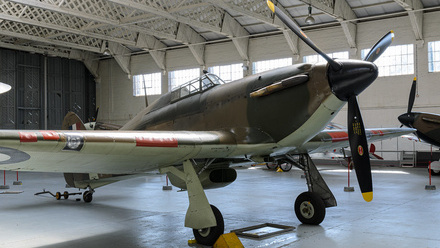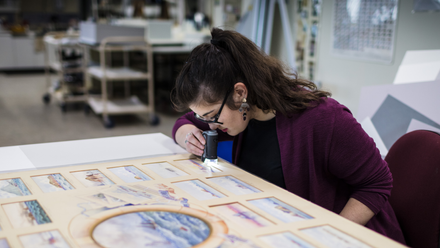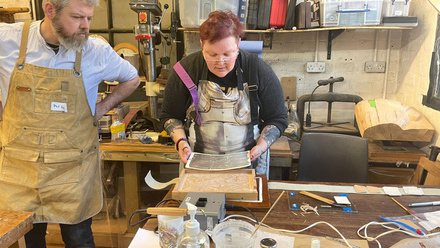Many commercially available options exist, but this style of book cushion offers a simple to use one-piece construction, with high sides that allows you to adjust your book’s opening angle anywhere between 45-160 degrees.
Due to the materials used, this book cushion is designed for temporary use such as short term consultation, conservation work, or exhibitions that don’t exceed a few hours. Using just two pattern pieces, this medium-sized book cushion will take an average sewer 3-4 hours to complete.
Illustrations: Gretchen Allen
Words: Rachel Sawicki
Download the full manual here (PDF)
Step 1: Select your fabric. Undyed and untreated cloth made from cotton or linen will give great results, as will polyester. Fabrics that are tightly woven and smooth textured will avoid snagging your precious books. Using plain hot water, wash your fabric to pre-shrink it, then iron ready for cutting.
Step 2: Print the pattern piece overleaf onto paper - use a ruler to ensure the 5cm x 5cm TEST SQUARE has expanded to the correct size. If you don’t have a printer, you can expand the pattern to the correct size on screen and then carefully trace the pattern onto paper directly from the screen of your device. (You can find the full scale pattern in the PDF document here)
Step 3: Pin the printed pattern to your cloth, ensuring you have placed the ‘CUT ON FOLD’ marking along the fold of your cloth. Cut around the paper pattern precisely, a 10mm seam allowance is included. You will end up with an M-shaped piece. Cut 2 of these pieces for each book cushion.
Step 4: Cut a long strip of cloth using the measurements below. A rotary cutter and straight edge will help ensure a nice straight cut. You will need 1 of these for each book cushion.
Step 5: Using a fabric pencil, mark the centre points of your long strip of cloth and both M-shaped pieces. This will help you accurately align the 3 pieces.
Step 6: Using the longest stitch setting on your sewing machine, sew a loose gathering stitch around the 2 curved parts of your M-shaped pieces. Sew within your 10mm seam allowance (i.e. 5-8mm in from the edge of your fabric) for approximately 12cm in length. Ensure you leave long tails of thread that can be easily pulled, and do not backstitch (reverse stitch) as you need these threads to stay loose. Gently pull the gathering threads to form a gentle curve in your cloth.
Step 7: Align the centre markings on your long strip of cloth with the centre of your M-shaped pieces. Carefully pin your pieces together in manageable sections as indicated. Adjust your gathering stitches as you go to help ease the long strip of cloth around the curves of your M-shaped pieces.
Step 8: Using a small stitch length, machine sew the pieces together keeping the gathered cloth on top and using a 10mm seam allowance. You might find it easier to sew from the centre upwards, effectively sewing the curves in two separate runs. Ease the curves as you go – this is the trickiest part to sew. Use your quick-unpick to remove any stitches and re-sew if any pesky puckers appear. Remember to use your reverse stitch setting at the beginning and end to ensure your seams won’t pull apart. Once you have sewn around the curves, pin the remaining straight sides together and sew until the ends of the long strip of cloth touch together at the bottom.
Tip: As you approach your bottom corners, you’ll need to swivel the cloth 90 degrees. To do this, sew towards the corner, stopping 10mm away from the end of the fabric. Lower the needle into the fabric, then lift the pressure foot up. Pivot your cloth 90 degrees swivelling the long strip of cloth parallel with the bottom edge of your Mshaped piece. Lower your pressure foot then continue sewing up to your half-way mark.
Step 9: When you are happy with your seams, clip away any stray thread ends and remove your gathering stitches. Cut V-shaped notches out of your curved-seams. Cut your notches through both layers of cloth close to the stitch line, ensuring you don’t cut through your sewing thread. Cutting notches allows curved seams to sit flat when turned the right way out.
Step 10: Now you’re ready to close the bottom seam of your cushion. Bring the 2 short edges of the long strip together. Check your previous pencil marks to ensure all your pieces are aligned perfectly in the centre. Pin together, leaving an opening in the middle wide enough to fit your hand (i.e. 10- 15cm). Sew your seams together either side of the opening, ensuring you backstitch the seams.
Step 11: This will be your last chance to neaten up your sewing, reinforce any seams, and clip stray threads. Using the opening in your base, reach your hand inside and pull your book cushion the right way out. Give your fabric a final iron as best you can. Once you’re happy with the construction, you’re now ready to fill your book cushion with beans.
Step 12: You may need a helper to fill your book cushion with beans, as statically-charged beans can make this a messy process. Your book cushion will take approximately 165 grams of beans, which you might like to measure out in advance. A paper cone inserted into your seam opening will help keep the beans under control. Once your beans have trickled into place, check the feel of your cushion. It is best not to overfill your book cushion, leaving wriggle-room will allow for a better range of spine movement and adjustments for your precious books. Step 13: Your last step is to close your seam opening. Using your trusty needle and thread neatly hand-sew the seam together, a curved needle will help you obtain a nice flat seam.
Step 14: Gently adjust the beans in your book cushion by pressing the valley and sides into your desired shape. You can easily bias the angle by pressing more beans to the right or left hand sides to suit the opening angle that your book requires. If your book has acid decayed leather, protect your fabric by placing a barrier underneath the book. Et voila, your beautifully completed book cushion is now ready for your precious books to recline upon!
Pattern hacks: Now that you have conquered your first book cushion, the pattern provided will scale upwards and downwards giving you infinite size possibilities – you’ll just need to adjust the size of your long strip of cloth and amount of beans to suit your requirements. For smaller book cushions, you could consider using archival polypropylene pellets for a recyclable filling option. The more advanced sewers amongst you could also consider upscaling the pattern slightly to make removable (washable) covers to go over your lovely book cushions. To do this, just attach some fastenings (buttons, press studs, zipper, Velcro™, or ties) along the base opening of the cover.
Good luck and happy sewing!
Illustrations: Gretchen Allen
Words: Rachel Sawicki





